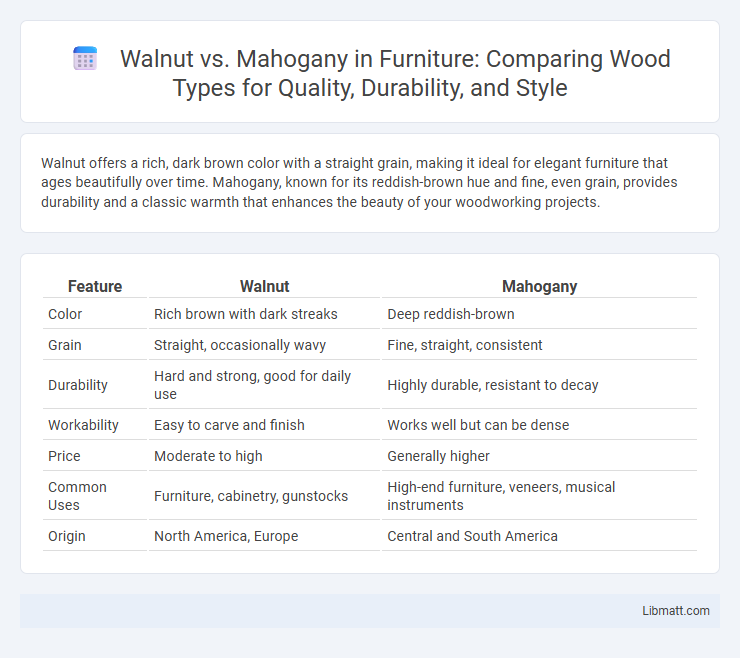Walnut offers a rich, dark brown color with a straight grain, making it ideal for elegant furniture that ages beautifully over time. Mahogany, known for its reddish-brown hue and fine, even grain, provides durability and a classic warmth that enhances the beauty of your woodworking projects.
Table of Comparison
| Feature | Walnut | Mahogany |
|---|---|---|
| Color | Rich brown with dark streaks | Deep reddish-brown |
| Grain | Straight, occasionally wavy | Fine, straight, consistent |
| Durability | Hard and strong, good for daily use | Highly durable, resistant to decay |
| Workability | Easy to carve and finish | Works well but can be dense |
| Price | Moderate to high | Generally higher |
| Common Uses | Furniture, cabinetry, gunstocks | High-end furniture, veneers, musical instruments |
| Origin | North America, Europe | Central and South America |
Introduction to Walnut and Mahogany
Walnut is a hardwood known for its rich, deep brown color and straight grain, commonly used in fine furniture and cabinetry. Mahogany, prized for its reddish-brown hue and smooth texture, is often utilized in high-end woodworking and musical instruments. Both woods offer durability and aesthetic appeal, but walnut typically features a cooler tone while mahogany exhibits a warmer, more vibrant finish.
Botanical Origins and Species
Walnut wood primarily comes from trees in the Juglans genus, especially Juglans regia (English walnut) and Juglans nigra (black walnut), native to regions in North America and Europe. Mahogany refers to several species within the Meliaceae family, notably Swietenia macrophylla (Genuine Mahogany) found in Central and South America, prized for its rich color and workability. Understanding these botanical origins helps you choose between walnut's durability and mahogany's distinctive grain for your woodworking or furniture projects.
Color and Grain Characteristics
Walnut features rich, dark brown hues with occasional purple or gray undertones, complemented by a straight grain that can sometimes appear wavy or curly for added texture. Mahogany offers a reddish-brown color that deepens with age, exhibiting a consistent, straight grain pattern with a fine, even texture. Both woods are prized for their luxurious appearance, but walnut's cooler tones contrast with mahogany's warm, reddish warmth.
Durability and Hardness Comparison
Walnut, with a Janka hardness rating of approximately 1,010, offers moderate durability suitable for furniture that balances beauty and functionality. Mahogany is harder and more durable, typically scoring around 1,070 to 2,200 on the Janka scale depending on the species, making it a preferred choice for high-traffic areas and heavy-use furniture. Both woods resist wear well, but mahogany's higher density provides enhanced resistance to dents and scratches compared to walnut.
Workability and Ease of Use
Walnut offers excellent workability due to its fine, straight grain and moderate hardness, making it easy to saw, carve, and finish for detailed woodworking projects. Mahogany is also prized for its smooth texture and stability, allowing for effortless shaping and sanding, but its density can require sharper tools and more effort during cutting. When choosing between the two, your project's complexity and tool sharpness will determine which wood provides greater ease of use.
Common Uses in Furniture and Woodworking
Walnut is prized for its rich, dark color and tight grain, commonly used in high-end furniture, cabinetry, and intricate woodworking projects due to its durability and workability. Mahogany features a reddish-brown hue and smooth texture, making it a favorite for classic, elegant furniture pieces, musical instruments, and detailed carving. Choosing between walnut and mahogany depends on your desired aesthetic and the specific requirements of your woodworking project.
Cost and Market Availability
Walnut typically commands a higher price due to its rich grain and durability, but its market availability is relatively stable thanks to widespread cultivation and sustainable harvesting practices. Mahogany, often more expensive than walnut, faces limited supply especially for genuine species from Central and South America, resulting in fluctuating market availability and higher costs. Both woods are valued in premium furniture markets, but walnut offers greater accessibility at a slightly lower cost compared to the rarer, more exotic mahogany.
Sustainability and Environmental Impact
Walnut wood is often considered more sustainable than mahogany due to its faster growth rate and availability from temperate forests, reducing the need for deforestation. Mahogany, primarily sourced from tropical rainforests, faces significant environmental concerns related to illegal logging and habitat destruction. Choosing walnut supports responsible forestry practices, helping minimize your environmental footprint.
Maintenance and Care Tips
Walnut wood requires regular dusting and occasional oiling with a natural wood polish to maintain its rich color and prevent drying. Mahogany benefits from cleaning with a damp cloth and periodic application of wax or furniture polish to enhance its deep reddish-brown hue and protect against moisture damage. Both woods should be kept away from direct sunlight and extreme humidity to prevent warping and fading.
Choosing Between Walnut and Mahogany
Choosing between walnut and mahogany depends on the desired aesthetic, durability, and project type; walnut offers rich chocolate brown tones and a smooth grain, ideal for fine furniture and detailed woodworking. Mahogany features a reddish-brown hue with exceptional stability and resistance to warping, making it suitable for cabinetry and high-end architectural joinery. Both hardwoods provide excellent workability and longevity, but walnut tends to be slightly more expensive due to its limited availability.
walnut vs mahogany Infographic

 libmatt.com
libmatt.com